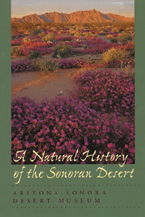A Natural history of the Sonoran Desert, 1st ed.
Arizona-Sonora Desert Museum
Edited by Steven J. Phillips & Patricia Wentworth Comus
Welcome to the Sonoran Desert
Gary Paul Nabhan
Imagine crossing a threshold — not into someone’s home but into another world. Imagine that world to be inhabited by creatures with names as wild as Gila monster, chuckwalla, vinagaroon, boojum and devil’s claw. Close your eyes, and smell a world filled with the fragrances of night-blooming cactus flowers, sacred datura, and the aromatic oils of creosotebush released into the air after the first summer rains. Listen hard, and hear the distant calls of Cactus Wrens, cicadas, Scaled Quail, Curve-billed Thrashers and spadefoot toads. Then open your eyes again, and see that the world you’ve entered into is swarming with leafcutter ants, carpenter bees, hummingbirds, and kangaroo rats.
You have not entered into someone else’s home, but one which for a day, a year, or an entire lifetime, may be your own: the Sonoran Desert. It is a homeland that rambles over some 120,000 square miles (320,000 km2) in two countries and five states. It is home to 130 species of mammals, more than 500 kinds of birds, 20 amphibians, 100 or so reptiles, and 30 native freshwater fish. Perhaps as many as 3500 native species of plants occur within the Sonoran Desert proper, of the 5000 or so which occur in Sonora, Arizona, Baja California, and adjacent southern California. This region is also home to at least seventeen indigenous cultures, as well as many others which have adopted it: Latino and Anglo, Chinese and Chicano, Arabic and African in origin.
Not far from the upland edge of this desert is a museum which serves as its threshold — an entry point through which the richness of the Sonoran Desert is revealed. For roughly a half century, the Arizona-Sonora Desert Museum has introduced more people to the flora, fauna, and habitats of this unique region than has any other medium of environmental education. Today, over a half million visitors come through its doors each year; several hundred thousand more receive its message through its publications, through its web site and annual conservation conferences, and through “The Desert Speaks”, a tv collaboration with The Nature Conservancy and the University of Arizona. In short, the Museum’s staff have done much to discover the living riches of this region, and have explored the many ways to celebrate and elucidate the value of its habitats to the whole of human society.
When the Museum staff began to work on this natural history of our region, our initial intent was to distill into a single publication the essential stories that we had gathered together in our various training courses over the decades. We had trained thousands of docents (volunteer interpreters) to help us tell visitors about the creatures and characters, the scenes and the scenery, the ecological processes and plots around which these stories revolve. We wanted to capsulize what we had all learned in this ecological theater, so that others would be aware of the wonderful evolutionary play going on all around us.
As we began to edit older writings and drawings we had used over the years, we realized how many of those stories had changed since their last telling, how innovative research by our own staff and by others had shifted the plots, and added new characters, both heroes and villains. We began to write an entirely fresh compilation of these character profiles and essential vignettes as new means to explain how a desert really works. As we read one another’s chapters and discussed them, we realized how richly complex and startling our new understanding of the desert’s patterns had become. Rather than portraying the Sonoran Desert as a stark, biologically impoverished landscape where all creatures compete “tooth and claw” for scarce resources, we were surprised by how many mutualisms — interactions between species which benefit each other — occur all around us. We were in awe of the implications of recently published inventories which demonstrate that deserts — not rainforests — are richest in pollinator diversity and perhaps in reptile diversity as well. We were also saddened to learn how rapidly this diversity is disappearing, as uninformed people who believe the Sonoran Desert to be a wasteland unknowingly turn it into one.
This book, then, is a fresh look at the ecological and cultural patterns which shape the richest, most complex desert in all of the Americas. If you have the chance to cross the threshold, to let its creatures and cacti speak directly to you, leaf through this book before you go and after you return. Read it by campfire light at night, or when you get stuck below a rocky overhang that summer day when a sudden downpour forces you to head for cover. Savor it as you sit beneath a saguaro cactus, eating the succulent fruit, hearing the breeze make music as it blows through the cactus spines — a living thumb piano. And use this book as a wellspring for reflection, to remind all of us human mortals that there are other lives on the face of this earth which enrich our own.
